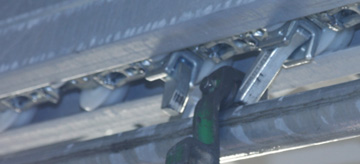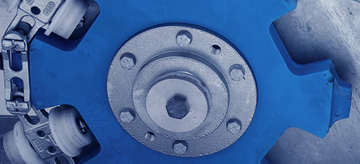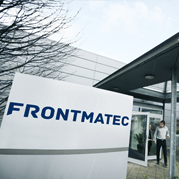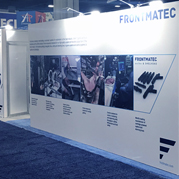The beef carcass rail system is a key component of the meat processing industry. A beef carcass rail system is a specialized meat processing system that is used for transporting and storing beef carcasses during the processing and packaging stages. The rail system is also used to convey other meat products, such as pork and chicken, from one area of the slaughterhouse to another.
The beef carcass rail system consists of a series of rails that are installed in the slaughterhouse. The rails are made of stainless steel or other corrosion-resistant materials. The beef carcasses are hung on hooks that are attached to the rails. The hooks are spaced at regular intervals so that the beef carcasses can be transported without touching each other.
The beef carcass rail system is operated by a series of pulleys and motors. The beef carcasses are moved along the rails by the pulleys. The motors are used to control the speed of the beef carcasses as they are moving along the rail system.
A beef carcass rail system is essential for meat processing plants
Without the beef carcass rail system, the meat processing industry would not be able to function effectively. The beef carcass rail system is an important part of the slaughterhouse or meat processing plant because it helps to keep the beef carcasses moving through the slaughterhouse or meat processing plant in a timely and efficient manner. Without the beef carcass rail system, the beef carcasses would have to be moved by hand, which would be a very slow and tedious process.
Beef carcass rail systems are an important part of the meat processing industry, as they help to improve efficiency and reduce the risk of contamination during the processing and packaging stages. The rails are designed to keep the beef carcasses moving smoothly through the processing facility, which helps to reduce processing times and increase throughput. Additionally, the rails are typically designed to allow for easy cleaning and maintenance, which helps to reduce the risk of contamination and improve food safety.
Overall, a beef carcass rail system is an essential component of any modern meat processing facility, as it helps to improve efficiency, reduce contamination, and ensure that the highest quality beef products are produced.
Bi-line conveyor systems
A bi-line conveyor system is a type of conveyor system that utilizes two conveyor lines running parallel to each other, with a common drive unit. The two conveyor lines can be configured in various ways, such as one line moving faster than the other or the two lines moving in opposite directions.
The advantages of a bi-line conveyor system include increased efficiency, flexibility, and reduced floor space requirements. By using two parallel conveyor lines, the system can handle more products at a faster rate compared to a single conveyor system. Additionally, the two lines can be configured to handle different types of products or perform different operations, providing greater flexibility in the production process. Finally, a bi-line conveyor system can help reduce the amount of floor space needed for production by maximizing the use of available space.
In beef processing, a bi-line conveyor system can be used for transporting carcasses, meat cuts, and other products along the production line. Here are the basic steps for how a bi-line conveyor system could be used in beef processing:
- After the animal is slaughtered and dressed, the carcass is transported on a bi-line conveyor system to the initial processing area.
- The carcass is then cut into primal cuts, such as rib, loin, and round, and each cut is placed on a separate conveyor line.
- Each conveyor line can then transport the primal cuts to their respective processing areas, where the meat can be trimmed, deboned, and separated into smaller cuts.
- The smaller cuts can then be placed on a conveyor line for further processing, such as grinding or packaging.
- The final products can then be transported on a separate bi-line conveyor system to the storage or distribution areas.
In this way, a bi-line conveyor system can help optimize the beef processing workflow, reduce labor costs, and improve efficiency and safety in the production process. Additionally, the bi-line conveyor system can be designed to meet specific sanitation and hygiene requirements in the meat processing industry, such as easy-to-clean surfaces, sanitary design, and stainless steel construction.
Flait rail conveyor system vs. bi-line rail conveyor system
The main difference between a flat rail conveyor system and a bi-line conveyor system is the number of conveyor lines used. A flat rail conveyor system uses a single conveyor line to transport products, while a bi-line conveyor system uses two parallel conveyor lines with a common drive unit.
In meat processing, both types of conveyor systems can be used for various applications. Here are some examples of how they could be used:
- Flat rail conveyor system: A flat rail conveyor system can be used for transporting carcasses or meat cuts along a straight line. It is commonly used in beef processing to transport the whole carcass from one processing area to the next. The conveyor system can be designed with adjustable rail heights to accommodate different carcass sizes, and the speed can be adjusted based on the processing needs.
- Bi-line conveyor system: A bi-line conveyor system can be used in beef processing for transporting meat cuts to different processing areas. For example, one conveyor line could transport primal cuts to the trimming area, while the other conveyor line could transport deboned meat to the grinding area. This type of conveyor system can help optimize the processing flow and improve efficiency, as products can be transported in different directions simultaneously.
Overall, both flat rail and bi-line conveyor systems have their own advantages and disadvantages, and the choice of system will depend on the specific processing needs and requirements of the meat processing facility. Factors such as speed, capacity, product size and weight, hygiene requirements, and floor space should be considered when selecting a conveyor system for meat processing.
Why invest in a meat trail system
Investing in a meat rail system for beef carcasses can offer several benefits for meat processing facilities, including:
- Improved hygiene and food safety: By keeping the beef carcasses off the floor and away from potential contaminants, a meat rail system can help reduce the risk of contamination and improve food safety. The system can be designed with easy-to-clean surfaces and materials to maintain high levels of hygiene.
- Increased efficiency: A meat rail system can help optimize the beef processing flow by reducing the need for manual handling and transportation of carcasses. Carcasses can be hung on the rails and easily transported to different processing areas, saving time and labor costs.
- Better product quality: A meat rail system can help maintain the quality and freshness of the beef carcasses by minimizing handling and reducing the risk of damage during transportation. The system can also be designed to ensure proper airflow and temperature control, which can help prevent spoilage and extend the shelf life of the meat.
- Worker safety: A meat rail system can improve worker safety by reducing the need for manual handling of heavy carcasses, which can lead to injuries and accidents. This can help create a safer work environment.
- Compliance with regulations: A meat rail system can help meat processing facilities meet government regulations related to beef carcass transportation and handling.
- Cost-effective: A meat rail system can be a cost-effective investment for meat processing facilities, as it can help increase efficiency and productivity while reducing labor costs and waste.
Overall, investing in a meat rail system for beef carcasses can be a wise investment for beef processing facilities, as it can help improve hygiene, increase efficiency, maintain product quality, enhance worker safety, and ensure compliance with regulations.
If you are looking to improve your beef slaughtering operation investing in a meat rail system for beef carcasses can be a wise investment. It can provide significant benefits in terms of efficiency, safety, quality, and compliance.
Contact us today if you want to know more about the benefits.

 EN
EN
 English
English
 中文
中文
 Español
Español
 Deutsch
Deutsch
 Français
Français





